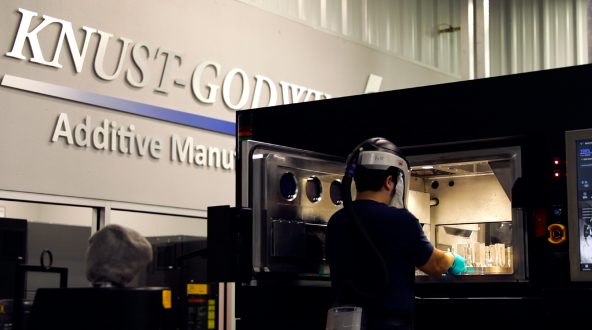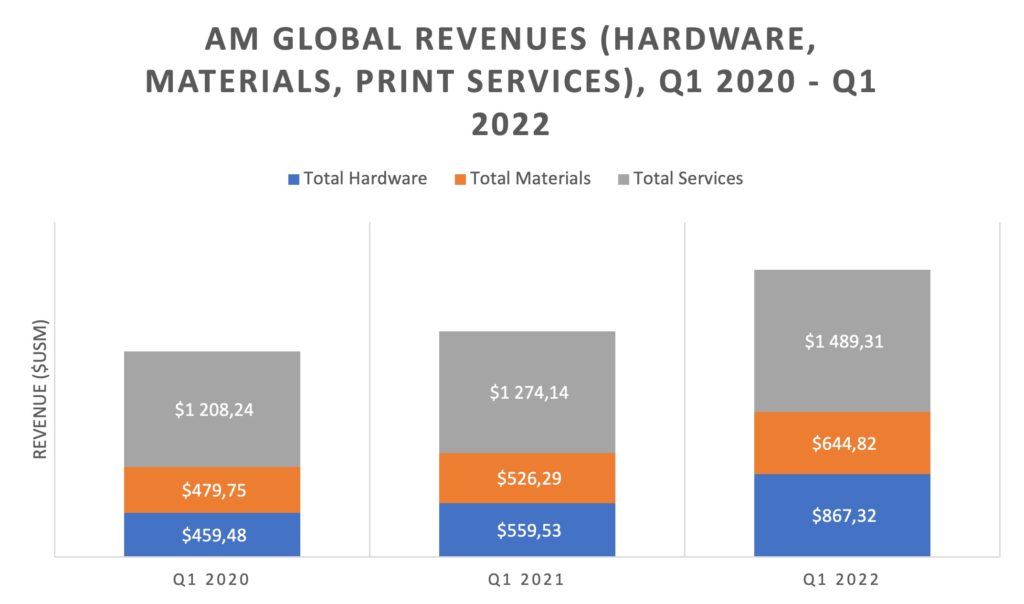SmarTech Analysis has released its latest quarterly data for the additive manufacturing (AM) industry, indicating a very strong start to the year for the sector. According to the AM market research group, the 3D printing market grew to $3 billion in Q1 2022, which represents 27 percent growth compared to the same period in 2021.
If the sector is able to whether the negative effects of inflation and global supply chain disruptions, SmarTech suggests that the printers, materials, and service markets could generate $12 billion by the end of the year. That compares to $10.6 billion for 2021. That caveat, however, is a critical one. Latest insight reports associated with the SmarTech data indicate that there are macroeconomic challenges on the horizon that could slow the quick growth already observed for the year.

Contract manufacturer Knust-Goodwin purchased additional metal 3D printers from VELO3D. Image courtesy of VELO3D.
The new information is integrated into SmarTech’s “Core Metals” and “Core Polymers” market data products, which include historical quarterly data and provide 10-year forward forecasts. Quarterly reports on the metal and polymer AM markets can be accessed as a one-time or subscription and are customizable as needed.
Scott Dunham, SmarTech Analysis EVP Research, commented, “The first quarter of 2022 was historic for the additive industry, with sequential growth continuing in earnest even beyond the rebound of 2021. Utilization of AM technologies is strengthening rapidly all over the world as the supply chain continues to be a challenge. The longer this continues, the better the outcomes for quality AM platforms. However, we should not be quick to dismiss the additive world as being insulated from the macroeconomic challenges of inflation and recession. If costs continue to creep up and are passed on to users, a lot of the work the AM community has done to make these processes more cost effective (and therefore more attractive to manufacturing) may be derailed, slowing growth.”
According to SmarTech, the professional AM markets for printers, materials, and services is 40 percent larger than it was in Q1 of 2020. As discussed in previous articles, this was driven in large part by the benefits of the technology when faced with supply chain disruptions caused by COVID response. The market research company believes that the industry isn’t developing in the same way as in the past, meaning that this increase in revenues isn’t like past cycles.
SmarTech notes that, while “the value proposition for the technologies is largely unchanged, “yet the appetite in the market appears to have grown significantly.” This growth isn’t being pushed by what has previously been the “typical cycle” of new technologies, in which hardware revenues increase as people explore these developmental machines. Rather, SmarTech suggests that hardware sales are increasing alongside hardware utilization.
Additionally, the report argues that not only is the AM industry different this time around, but so are market conditions. In the past, when there have been incentives for AM adoption, these were blocked by obstacles to growth. Now, however, issues such as supply chain disruptions, sustainability, and cost reductions favor the use of 3D printing.
This is combined with the fact that AM itself has advanced. 3D printers are more productive and stable. Manufacturing execution software for AM has improved. There are more and better design tools for 3D printing. The standards for the industry have also increased to a degree. With this in mind, there are now more customers who have the necessary tools to actually implement AM effectively.
In other words, all of the pieces are there to drive further growth for the AM sector. The biggest variable is whether the world around it will allow for that expansion. Inflation has reached all-time highs and the stability of the oil and gas market is precarious, not to mention its impact on the surrounding ecosystem. If the global economy can maintain some semblance of stability—possibly even if it can’t—AM may continue to develop apace.
For more information on stand-alone reports or ongoing subscription services for the additive market, go to the SmarTech website.
Subscribe to Our Email Newsletter
Stay up-to-date on all the latest news from the 3D printing industry and receive information and offers from third party vendors.
You May Also Like
3D Printing Unpeeled: New Arkema Material for HP, Saddle and Macro MEMS
A new Arkema material for MJF is said to reduce costs per part by up to 25% and have an 85% reusability ratio. HP 3D HR PA 12 S has been...
3D Printing News Briefs, January 20, 2024: FDM, LPBF, Underwater 3D Printer, Racing, & More
We’re starting off with a process certification in today’s 3D Printing News Briefs, and then moving on to research about solute trapping, laser powder bed fusion, and then moving on...
3D Printing Webinar and Event Roundup: December 3, 2023
We’ve got plenty of events and webinars coming up for you this week! Quickparts is having a Manufacturing Roadshow, America Makes is holding a Member Town Hall, Stratafest makes two...
Formnext 2023 Day Three: Slam Dunk
I’m high—high on trade show. I’ve met numerous new faces and reconnected with old friends, creating an absolutely wonderful atmosphere. The excitement is palpable over several emerging developments. The high...

































